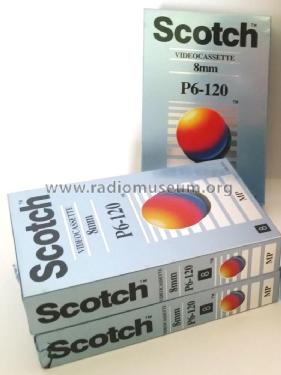Scotch - Video 8 - 8mm Video Cassette All
3M, Lake Superior
- Country
- United States of America (USA)
- Manufacturer / Brand
- 3M, Lake Superior
- Year
- 1985 ?
- Category
- Miscellaneous (Other, Various) - see notes
- Radiomuseum.org ID
- 265426
- Wave bands
- - without
- Details
- Special Tape or Cassette-Format
- Power type and voltage
- No Power needed
- Loudspeaker
- - - No sound reproduction output.
- Material
- Plastics (no bakelite or catalin)
- from Radiomuseum.org
- Model: Scotch - Video 8 - 8mm Video Cassette [All] - 3M, Lake Superior
- Shape
- Miscellaneous shapes - described under notes.
- Dimensions (WHD)
- 95 x 62.5 x 15 mm / 3.7 x 2.5 x 0.6 inch
- Notes
-
This page is for all SCOTCH labeled VIDEO 8 type Video Cassette tapes for all TV standards. (Non Hi8 or Digital!)
Please do not modify this page.
Load only pictures with all data in the picture legend!
Bitte nur Bilder hochladen, alle Informationen/Daten in die Bildlegende.
History (Extracts taken from Wikipedia):
"The 8mm video format refers informally to three related videocassette formats for the NTSC and PAL/SECAM television systems.
These are the original Video8 (analog recording) format and its improved successor Hi8 (analog video and analog audio but with provision for digital audio), as well as a more recent digital recording format known as Digital8.
Their user base consisted mainly of amateur camcorder users, although they also saw important use in the professional television production field.
In 1985, Sony of Japan introduced the Handycam, one of the first Video8 cameras with commercial success. Much smaller than the competition's VHS and Betamax video cameras, Video8 became very popular in the consumer camcorder market.
Tape and recording protection:
The write-protect switch (right) prevents accidental erasure. As with many other video cassette formats, 8mm videocassettes have a tape-protecting mechanism built into the shell.
Unlike the ones on VHS and VHS-C shells, which consist of only a single piece of plastic that protects the part of the tape that is read by the player/recorder, Hi8's tape-protection mechanism consists of two pieces of plastic at the top of the shell that come together and form a casing that protects both sides of the tape, and a latch that prevents this casing from opening and exposing the tape. The playback/recording unit can depress this latch to open the casing and gain access to the tape. To prevent the recording on the tape from being erased, there is a small write-protect tab that can be moved to one of two positions, labeled "REC" and "SAVE". Comparing the sliding tab to a door, the tape is in the "REC" position is when the "door" is open and the "SAVE" position when it is closed. (Not all tape cases have markings for this information.) The tape can only be recorded on (or recorded over) when this tab is in the "REC" position. This is an improved version of the VHS write-protect tab, which prevents erasure after it has been broken off, requiring covering with adhesive tape to remove the write protection. "
- Author
- Model page created by a member from A. See "Data change" for further contributors.
- Other Models
-
Here you find 18 models, 18 with images and 0 with schematics for wireless sets etc. In French: TSF for Télégraphie sans fil.
All listed radios etc. from 3M, Lake Superior

